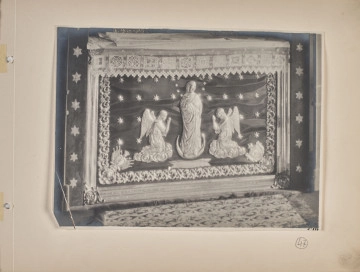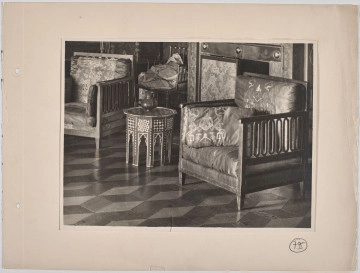
Interiors. Turkish Suite
20th century
Castle Museum in Łańcut
Part of the collection: Interiors
Historical names: bedroom “Chambre à Coucher” (ca. 1780); “Pokoy”/the room (early 19th c.); “the Bedroom” (mid- 19th c.); the Men’s Bedroom (1933)
Other names: The Master’s Bedroom; the Men’s Bedroom; the Men’s Suite Bedroom
Time of construction: 1629–1642 (?); from ca. 1780 – “Chambre à Coucher”; late 19th c. change of decor; 1890s – change of decor
Architects: N.N. (1629-1890s); Amand Louis Bauqué, Albert Pio (1890s change of decor)
Artists: Viennese carpenters (1890s)
Description:
The Men's Bedroom is located in the northern suite of the castle’s first floor. In the 18th century, it housed private apartments of the then owners – Izabela née Czartoryski and Stanisław Lubomirski, Grand Crown Marshal at the court of Stanisław August Poniatowski.
Around 1780 the room described as “Chambre à Coucher” was used as a bedroom for Prince Stanisław Lubomirski. The room had two windows in the northern wall and two in the enfilade. The bedroom was heated by a fireplace located in the eastern wall and a stove in the recess of the western wall (with a hearth accessible from the Northern Corridor). There was a bed in the southern alcove.
After the death of Stanisław Lubomirski in 1783, his apartment underwent partial alterations and adaptations. In 1802, the interior called “Pokoy” still served as a bedroom and had a “Cover on canvas in a green colour with a paper trail in Flowers and Trails”. There was a magnificent “Tambour with an oval black landscape behind glass, also embossed with upholstery, where Pavimote also folded in 4” and a “Wooden bed with curtains”.
At the beginning of the 19th century, part of Stanisław Lubomirski's apartment was occupied by L'Abbée Rufin – a clergyman, probably one of the emigrants supported by Izabela Lubomirska after the French Revolution. The equipment in his bedroom did not change. In 1805, the walls were still covered with the same “aquamarine canvas” draperies with a paper trail. There still was a “Tambour made of sawn timber with a cornice, covered with a cloth such as upholstery, with a paper trail with coloured flowers, with an oval window, black silhouettes on a black chine fabric, behind glass depicting horses and pedestrians.” A three-paned mirror hung on the wall between the windows, and another four-paned mirror above the fireplace. Next to the room, was “a little wardrobe”, probably the same one that was mentioned in 1802 in the back room of the room adjacent to the west wall called “the Cabinet” (former “Garderobe du Prince”, now the Yellow Bathroom). In the mid-nineteenth century, this small transitional room was called a “retreat”.
After Izabela Lubomirska died in 1816, when the Łańcut castle became the property of her grandson Alfred I Potocki, the former “Chambre à Coucher” continued to serve as a bedroom with double white painted doors and two windows in the north wall. In the mid-nineteenth century, its walls were covered with wallpaper, and the floor was made of oak brick. In place of the “tambour” and the bed with curtains, there was a mahogany bed “decorated with bronze”. The room was heated by a “Round bricked stove” and a “Sapphire fireplace with green marble cladding”.
After Alfred I died in 1862, his son and successor of the ordinance Alfred II Potocki moved to the former Stanisław Lubomirski's suite. As recalled by Elżbieta née Radziwiłł, daughter-in-law of Alfred II, the Men's Bedroom was upholstered with English cretonne. There were two pairs of classicist panel doors in the room from the mid- 19th c. that still exist today. They were made of mahogany, sycamore and walnut. The door is inlaid on one side. The other is decorated with grotesque polychrome, with Vulcan and Venus (west door), Pluto and Clio (east door) placed in the central hexagonal panels. This door was installed in the bedroom around or shortly after 1862.
Following Alfred II's death in 1889, during the castle's reconstruction, carried out in 1889-1912 according to the designs of Amand Louis Bauqué and Albert Pio, the former apartments of the last Lubomirskis were arranged for Elżbieta and Roman Potocki. The Men's Suite Bedroom was renovated and redecorated in 1890-1895 for Roman Potocki.
The lower part of the walls has full panelling. Above it, on a loom frame panelling, red and amaranth Lyon damask was stretched. The panelling, painted in grey and aquamarine colour, was separated from the ceiling by a smooth facette with profiling. There is a panel above the inter-window mirror on the northern wall. There is a classicising beige marble fireplace with a framed mirror in the western wall and a white-tiled stove from the late 19th century. Behind the stove, the door, masked in the panelling, leads to a room separated from the former Dressing Room (the Yellow Bathroom), known in the mid-19th century as a “retreat”.
The interior is decorated with Polish and English furniture from the 19th century.
Basic bibliography:
• Kossakowska-Szanajca Zofia, Majewska-Maszkowska Bożenna, Zamek w Łańcucie, Warsaw 1964
• Majewska-Maszkowska Bożenna, Mecenat artystyczny Izabelli z Czartoryskich Lubomirskiej, Warsaw 1976
• Omilanowska Małgorzata, Jakub Sito, Łańcut i okolice [in:] Katalog Zabytków Sztuki w Polsce, Institute of Art of the Polish Academy of Sciences, Warsaw 1994
• Potocka Elżbieta, Łańcut – memoirs from 1885 to 1915 [Diary, typescript in the collection of the Castle Museum in Łańcut]
Elaboration:
Teresa Bagińska-Żurawska https://orcid.org/0000-0002-9243-3967
Faustyna Bożętka
Object type
Interiors
Creation / finding place
Owner
Castle Museum in Łańcut
Identification number
Location / status

20th century
Castle Museum in Łańcut

20th century
Castle Museum in Łańcut

20th century
Castle Museum in Łańcut
DISCOVER this TOPIC
National Museum in Szczecin
DISCOVER this PATH
Educational path